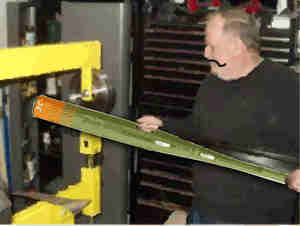In the 1980s composite bats started to make their way onto the baseball and softball scene but they were not well received because they did not perform as well as single walled aluminum bats on the market and interest was lost towards the early 1990s. Some companies still made a few composite bats but they, again were durable but not performing well. By the early 2000s composite bats were slowly picking up steam in the men’s slow pitch softball world. They started to perform a little better than aluminum with better durability but because the top 3 bat companies (Louisville Slugger, Worth and Easton) were not making them they were not main stream yet. In 2002 Miken Sports came out with the ”Velocite-E Ultra” and completely changed the game of slow pitch softball forever.

 This theory actually was proven in 2005 by Daniel Russell, Ph.D. at the Penn State University Graduate Program in Acoustics. The 2 bats tested gained 22.8 feet and 32.2 feet in distance to the batted ball. Although there is no known reference to the account Wikipedia states that bat rolling was invented by a Southern Californian named “Chepe” who ran his bat through an old English Wheel.
This theory actually was proven in 2005 by Daniel Russell, Ph.D. at the Penn State University Graduate Program in Acoustics. The 2 bats tested gained 22.8 feet and 32.2 feet in distance to the batted ball. Although there is no known reference to the account Wikipedia states that bat rolling was invented by a Southern Californian named “Chepe” who ran his bat through an old English Wheel. The most solid data on inventing a bat rolling machine comes from a company from North Carolina called Juiced Inc. In 2003 Juiced started development on the first bat rolling machine and in 2005 they manufactured a bat roller that would break in composite bats in a matter of minutes instead of days or weeks of batting practice.
The most solid data on inventing a bat rolling machine comes from a company from North Carolina called Juiced Inc. In 2003 Juiced started development on the first bat rolling machine and in 2005 they manufactured a bat roller that would break in composite bats in a matter of minutes instead of days or weeks of batting practice. 
The bat would be placed between 3 rollers and pressure would be added to the top rollers as the side handle would run the bat back and forth through the machine perpendicularly. As time went on bat rolling machines improved and the parallel bat roller we know of today was the standard, cutting the break in time down even more. The allure of bat rolling was obvious for composite bat owners; Hitting 500 to a 1000 balls during batting practice and also marking up the outside of the bat, as opposed to, running it through a bat roller in minutes.
Early on Sanctioning associations took a stance on “altered bats” stated that rolling was illegal (2008). Around 2012 bat manufacturers also started to put in their warranties that altering a bat would void the warranty. This fact did not deter hundreds of thousands of players to “alter” their bat through bat rolling. Bat rolling was not frowned upon even though it was deemed illegal. That sentiment stills resonates today if you search through forums and websites about the topic. To answer the original question of what made bat rolling so popular it is a simple answer: It works.